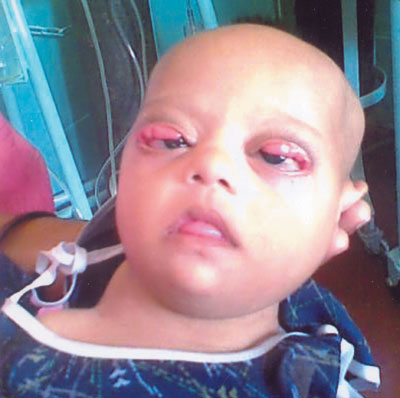A six month old girl presented with eversion of the uppereyelids since the
neonatal period. The eversion was more prominent on crying. She also had
clinical features of Down syndrome like generalized hypotonia, upward
slant of eyes and a protruding tongue (Fig.1). Skin
examination was normal. A clinical diagnosis of upper eyelid congenital
ectropion was made. As the ophthalmological examination revealed no
exposure keratopathy she was managed conservatively with corneal
lubricants. On follow-up at six months, her condition is stable.
 |
|
Fig. 1 Bilaterally everted upper eyelids in
Down syndrome. |
Ectropion is also associated with conditions like
collodion baby where the neonate is covered at birth by a thick membrane,
flattening of the ears and nose and o-shaped fixation of lips. Some forms
of chronic dermatitis like epidermolysis bullosa also cause ectropion in
the long run. Bells palsy and facial nerve palsy were ruled out by the
absence of facial palsy. Eyelid cysts, tumors and scarring due to trauma
were ruled out by their absence. Though the ocular findings in Down
syndrome are varied, ectropion is one of the rarest. This condition may
resolve spontaneously with conservative treatment or may need surgical
intervention to prevent complications if conservative treatment fails.

